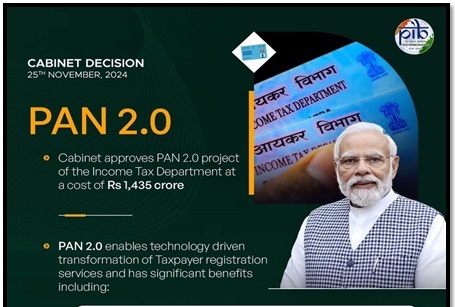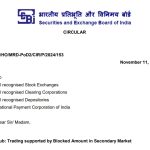PAN 2.0 has been floated as Common Business Identifier for business activities. It has been introduced as upgraded version of existing PAN Card which will facilitate integration of PAN (Permanent Account Number) and TAN (Tax Deduction and Collection Account Number), provide unified portal for all PAN related needs, set up a PAN Vault and equip PAN with dynamic QR Code. Dynamic QR Code with GPRS facility may prove a nightmare for PAN Card scamsters. GPRS equipped QR Code (whenever somebody will scan the QR Code, it will capture real time location of the scanner), if introduced, will prove an icing on the cake for PAN 2.0 users.
In this write up we will discuss technical details of PAN 2.0.
Upgradation of Financial Identity: PAN was introduced in the year 1972 as Income Tax Identification number. During last 50 years it has gone through various phases of upgradation and became a symbol of financial identity. Introduction of QR code in PAN and its linkage with Aadhar number made it the most sought-after card. No financial transaction can take place without PAN number, if it is beyond a threshold. It has become integral part of Suspicious Transaction Report (STR), Annual Information Return (AIR), reports generated under Prevention of Money Laundering Act (PMLA), Financial Forensic Audits, Registration of Property documents and filing of Income Tax Return (ITR). PAN 2.0 will upgrade Financial Identity electronically through QR Code based facility, enhanced safety features and storage of latest data in the card itself.
The importance of QR Code: QR Code is like a coded language. It’s optical in nature. Introduced in the year 1992 in Chinese automobile sector, it has found usage in almost all walks of life with enhanced features. The technology itself is very simple. The restaurant owners put it at their table for downloading menu card, the retailors use it for checking counterfeit and our RBI found its use in developing Bharat QR for making/receiving payments.
QR code stores information in four formats: numeric, alphanumeric, binary and kanji. It can be static or dynamic. Dynamic QR Code means updation of information at particular intervals. As deliberated by the Income Tax Department, PAN 2.0 will be enhanced with a dynamic QR code displaying the latest data from the PAN database. The QR code will facilitate validation of PAN details, ensuring authenticity. A dedicated QR reader application will be available to verify details. When scanned, it will display the holder’s photo, signature, name, parents’ names, and date of birth. These are the five co-ordinates of PAN Card.
Can PAN identity be stolen? PAN identity has been prone to being stolen due to three reasons: the alphanumeric nature of PAN Number, the hazy photo of holder, unclear signature and easy to copy design. There have been several instances where scamsters superimposed photo of holder and signature of other person to steal financial identity and got property registered. PAN related fraudulent activities became a bit difficult after PAN Adhaar linkage. Since Adhaar database preserves photograph of the holder, PAN became indirectly equipped with PAN holder’s digital photograph. But solo use of PAN for generating Director Identification Number (DIN) and Digital Signature (DSC), PAN identity are prone to being stolen/forged. It is expected that QR code enabled PAN card will check this menace. QR Code in itself is prone to copying, therefore dynamic QR is a must to outsmart skimmers and scamsters.
Duplicate PAN Card syndrome: Some individuals have acquired multiple number of PAN Cards during developing phase of PAN Card system. Possessing more than one PAN Card is an offence under Income Tax Act. It’s understood that the individuals having multiple PAN cards will come forward to surrender their extra PAN cards and the financial system and agencies will get real time data based on PAN Card QR code. The QR Code will contain information like holder’s photo, signature, name, parents’ names, and date of birth. It’s not clear whether it will contain ITR related information or not.
The information like holder’s photo, signature, name, parents’ names, and date of birth are static and therefore it may be presumed that the PAN 2.0 will contain data like ITR as well. Capturing ITR information along with TDS/TCS details through QR Code will make it easier for financial agencies to track information on real time basis and visa services authorities to verify financial credentials of an individual.
PAN Vault: PAN 2.0 envisages a PAN Vault system for storing PAN related financial data of 78 Crore PAN holders of Indian subcontinent. Storing financially sensitive data at a central place and sharing the same with related agencies is a herculean task. It will require state of the art server facility and impenetrable firewalls with multiple security layers. The sharing mechanism has to be with defined protocols so that economic data of individuals and companies are safe from hacks. Since PAN and Adhaar are linked and even TAN getting merged with PAN, the data management becomes all the more critical. Launch of unified portal for PAN related requirements is a good idea provided the web portal is hosted at a reliable server.
In short, PAN 2.0 may change a game changer provided QR Code is programmed dynamically and access to PAN Vault is based on well-defined access protocols.



